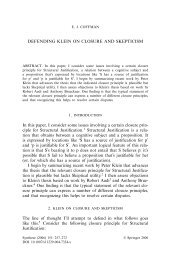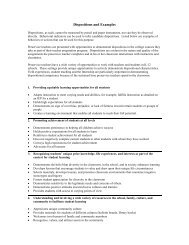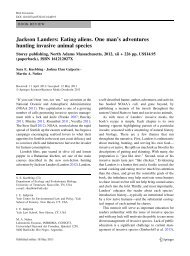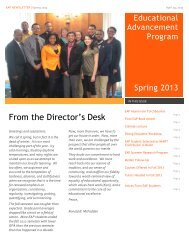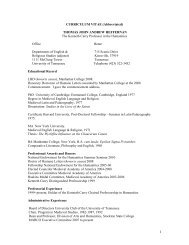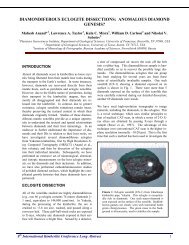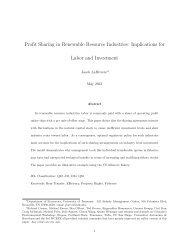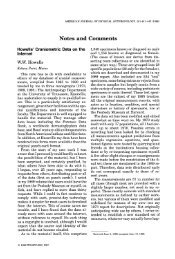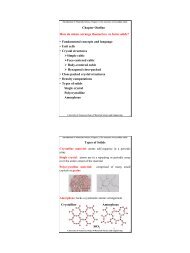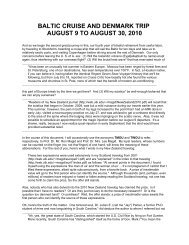Research - The University of Tennessee, Knoxville
Research - The University of Tennessee, Knoxville
Research - The University of Tennessee, Knoxville
You also want an ePaper? Increase the reach of your titles
YUMPU automatically turns print PDFs into web optimized ePapers that Google loves.
<strong>Research</strong> shows<br />
that our biological<br />
inclination to let loose<br />
by sarah elbert |<br />
helps photographs us deal by with life’s<br />
Dominique issermann/h&K/<br />
challenges, Cpi syndiCationinnovate,<br />
think more creatively—<br />
and, <strong>of</strong> course, it’s<br />
just plain fun.<br />
By Mark Anderson
e didn’t want to fight, but all the other kids on the<br />
playground had already made up their minds. If<br />
9-year-old Kevin Carroll was going to continue<br />
using this Philadelphia city park, he would need to<br />
go toe-to-toe with the new kid. So he did.<br />
Like wolf pups in a TV nature documentary—half horsing around and half<br />
holding their place in the pecking order—Carroll and the new kid rolled<br />
around in the dirt and faked some punches. <strong>The</strong> fight was convincing enough<br />
that none <strong>of</strong> the other kids could say Carroll wasn’t trying. But neither child<br />
was exactly crying or bleeding, either. Everyone else on the playground soon<br />
got bored and moved on to something else.<br />
Meanwhile, Carroll and the new kid found that they were having a blast.<br />
“You wanna come to my house for a peanut butter and jelly sandwich?” the new kid<br />
asked Carroll as they each dusted themselves <strong>of</strong>f.<br />
Carroll—now 52 and an acclaimed author and motivational speaker as well as a former<br />
trainer for the Philadelphia 76ers—had had what he calls a “red rubber ball moment.” Carroll<br />
had discovered how play can transform even tense, high-stakes moments into pure fun<br />
and form deep connections that can last a lifetime.<br />
Not only did Carroll become lifelong friends with the new kid, Norman Lane (who<br />
tragically died in a car accident at age 26), but he also was all but adopted by his new<br />
friend’s family. “Forty-three years I’ve known the Lanes,” Carroll says today. “I still have a<br />
key to their back door.”<br />
Carroll is one <strong>of</strong> a growing number <strong>of</strong> evangelists for play. But not just play in the<br />
dictionary sense. (As San Francisco psychiatrist Lenore Terr points out, some dictionary<br />
definitions tag play as something children do.) But also in the sense <strong>of</strong> anyone at any age<br />
tapping into that same childlike sense <strong>of</strong> wonder and playfulness, whether it’s in sports, in<br />
the workplace, in a hobby, in the kitchen or even just playing with one’s own kids.<br />
Stuart Brown, a medical doctor, psychiatrist and founder <strong>of</strong> the Carmel Valley, California-based<br />
National Institute for Play, says not only can play be beneficial, it’s actually essential:<br />
“Humans are designed by biology to play throughout their entire life cycle,” he says.<br />
“For a lot <strong>of</strong> animals . . . play pretty much disappears [when they’re grown]. For humans, it<br />
doesn’t. It changes. <strong>The</strong> drive for it is less in adulthood. But it’s still there.”<br />
Vacations, sports, resorts, hobbyist clubs and organizations—and indeed much <strong>of</strong> the<br />
world <strong>of</strong> arts and creativity—all attest to the human need for play. And Brown says brain<br />
deltaskymag.com July 2011 73
esearch suggests this state <strong>of</strong> mind<br />
is as deeply seated as it is <strong>of</strong>ten pr<strong>of</strong>oundly<br />
felt.<br />
Play, he says, “is not cognitive, linear<br />
thinking. And it’s not sleep and dreams.<br />
But it’s kind <strong>of</strong> the bridge between<br />
those. And it emanates from deep centers<br />
in the brain that are largely about<br />
feeling and survival.”<br />
For instance, Brown points to a<br />
landmark study by the Canadian neuroscientist<br />
Sergio Pellis, who examined<br />
rats, usually a playful species. However,<br />
Pellis’ team raised a cohort <strong>of</strong> rats who<br />
were systematically denied play from<br />
birth onward.<br />
<strong>The</strong> scientists<br />
then set a used<br />
cat collar in<br />
the rats’ cages.<br />
Hard-wired to<br />
flee at the scent<br />
<strong>of</strong> a cat, the playdeprived<br />
rats ran<br />
for shelter—as<br />
did a control<br />
group <strong>of</strong> rats<br />
who were not<br />
denied play.<br />
But after the<br />
initial moment<br />
<strong>of</strong> flight, the<br />
play-deprived<br />
rats fared worse<br />
and worse. “<strong>The</strong>ir stress<br />
levels stay up higher,”<br />
Brown says. “<strong>The</strong>ir ability<br />
. . . to begin to survive<br />
through foraging and getting<br />
food is greatly limited as<br />
compared to those rats who’ve<br />
had normal rough-and-tumble play,<br />
whose stress levels go down quicker.<br />
And they go out and enter the hazardladen<br />
world.”<br />
Play, in other words, seems to help<br />
the brain adapt and improvise when<br />
unexpected challenges arise.<br />
This conclusion is borne out over<br />
40 years <strong>of</strong> research and field work,<br />
during which Brown has conducted<br />
what he calls “play histories” <strong>of</strong> 6,000<br />
people, from Nobel laureates to hardened<br />
criminals. Some <strong>of</strong> the highest<br />
achievers in business, science and the<br />
74 July 2011 deltaskymag.com<br />
i have one ‘look up’<br />
day per week. i spend<br />
more time looking up<br />
than looking down. it<br />
allows me to see new<br />
things from new eyes.”<br />
arts, Brown finds, have some <strong>of</strong> the richest histories <strong>of</strong> play throughout<br />
their lives. “Either through their parents or through their own initiative,<br />
many successful people have maintained a common thread between early<br />
natural play tendencies and what they do in their adult lives,” Brown says.<br />
“For some, the work-play separation is virtually nonexistent.”<br />
he other end <strong>of</strong> the spectrum is perhaps just as instructive.<br />
<strong>The</strong> first play history Brown took, in fact, was a posthumous<br />
investigation into the life <strong>of</strong> Charles Whitman, an<br />
architectural engineering student at the <strong>University</strong> <strong>of</strong> Texas<br />
in Austin who on August 1, 1966, went on a horrific campus<br />
shooting rampage that killed 17 and wounded 31 before police<br />
gunned Whitman down.<br />
Reporting to Texas Governor John Connally, Brown noted that Whitman<br />
had evidently never experienced unfettered childlike play during<br />
his life. A superachiever who was the youngest Eagle<br />
Scout in the history <strong>of</strong> the Boy Scouts, Whitman was<br />
also as a youth denied every opportunity to horse<br />
around with his friends. Whitman’s father scorned<br />
play, saying his boy should instead be doing something<br />
“useful.”<br />
“When he was unable to handle his aggressive<br />
and hostile impulses when humiliated and stressed,<br />
he became preoccupied with violence,” Brown says.<br />
“He killed his wife and mother and all those people,<br />
with the façade <strong>of</strong> being Mr. Nice Guy, normal, Eagle<br />
Scout, good B-student and so on.” Of course, Whitman’s<br />
case is the far extreme <strong>of</strong> what Brown calls<br />
“play deprivation.” Nevertheless, denying normal<br />
impulses to play in less extreme ways still has con-<br />
—Kevin Carroll sequences for a person’s mental well-being.<br />
In his 2009 book Play: How It Shapes the Brain,<br />
Opens the Imagination, and Invigorates the Soul, Brown<br />
disputes a related common misperception. “<strong>The</strong> opposite<br />
<strong>of</strong> play is not work,” he writes. “<strong>The</strong> opposite <strong>of</strong> play is<br />
depression.”<br />
“A lot <strong>of</strong> the outcomes <strong>of</strong> a seriously play-deprived life are to<br />
have a kind <strong>of</strong> rigid and hopeless, driven way <strong>of</strong> looking at the<br />
world,” Brown says. “Your life is driven by security and responsibility<br />
. . . or [the belief] that every moment needs to be productive<br />
with a specific outcome. And yet the paradox <strong>of</strong> being human<br />
is that we become<br />
more responsible,<br />
more empathic,<br />
more productive<br />
by honoring our<br />
play nature.”<br />
So what is play?<br />
Terr, author <strong>of</strong> Beyond<br />
Love and Work:<br />
Why Adults Need to<br />
Play, calls it “activity<br />
aimed at having<br />
fun.” Brown, on<br />
the other hand,<br />
photos: page 72: kids: clockwise from top left: Brand new images, chris ted, mark mann, alexandra graBlewski,<br />
roBert daly, tay rees, fuse king; cut out photography: paul najlis. this page: swanson studio (kevin carroll).
says he’s seen it in too many different<br />
forms to be able to provide a universal<br />
definition. Rather, he highlights key<br />
properties: Play is something done for<br />
its own sake; it’s voluntary; there’s an<br />
inherent attraction to it; the player<br />
experiences a kind <strong>of</strong> freedom from<br />
time and perhaps loses track <strong>of</strong> his or<br />
her own self; it’s open to improvisation;<br />
and finishing it leaves one wanting<br />
to do more.<br />
very person, <strong>of</strong> course,<br />
has his or her own<br />
favorite forms <strong>of</strong> play.<br />
To find it for yourself,<br />
Brown says, think back<br />
to a moment <strong>of</strong> pure, childlike joy or pleasure as a youth.<br />
Perhaps it was a first bicycle or a birthday party or a family outing or vacation.<br />
Now, Brown says, “Whether you’ve got three kids and a tough job<br />
with a lousy boss or financial strain—ask yourself: How can I now find<br />
someplace in my existence to experience those feelings again?”<br />
<strong>The</strong> answer might be in sports or taking up an instrument or joining a<br />
book club or writers’ group. Maybe it’s as simple as trying out new recipes<br />
at dinner or building that model airplane you never got to make as a kid.<br />
For Carroll, getting to the root <strong>of</strong> play means reawakening that childlike<br />
sense <strong>of</strong> seemingly endless curiosity. Adults, he points out, <strong>of</strong>ten go<br />
through their days looking down, <strong>of</strong>ten these days at a screen. Whereas<br />
kids, he says, are more <strong>of</strong>ten looking up. “<strong>The</strong>y’re always trying to bring<br />
new things into their imagination,” he says. “I have one ‘look up’ day per<br />
week. I spend more time looking up than looking down. It allows me to<br />
see new things from new eyes.”<br />
Carroll, who has spoken to crowds <strong>of</strong> school kids, Fortune 500 executives<br />
and United Nations dignitaries, sees play as essential in the workplace.<br />
It can sometimes be sparked by the simplest object. “We all speak<br />
ball,” Carroll says. “When you bring a ball with you somewhere, people<br />
want to know, What are you going to do with that? It’s a magnet.”<br />
Carroll’s “red rubber ball” series <strong>of</strong> books—Rules <strong>of</strong> the Red Rubber Ball<br />
(2005), What’s Your Red Rubber Ball? (2008) and <strong>The</strong> Red Rubber Ball at Work<br />
(2008)—uses this centerpiece <strong>of</strong> sports as a metaphor for rediscovering<br />
and exercising the muscles <strong>of</strong> creativity everyone had as a kid. “I always<br />
tell people, play is serious business—and play is serious in business,”<br />
Carroll says.<br />
In Red Rubber Ball at Work, Carroll highlights the stories <strong>of</strong> 33 businesspeople,<br />
artists, writers, doctors, researchers and philanthropists who<br />
all have incorporated play into their worlds <strong>of</strong> work, with <strong>of</strong>ten<br />
life-altering and career-changing results.<br />
“Think back to your childhood,” Carroll writes. “Activities<br />
we called soccer, tap dancing, marbles, double-dutch, blocks<br />
and tag were also exercises in resourcefulness, planning,<br />
strategy, design, decision-making, creativity and risktaking.”<br />
As Red Rubber Ball at Work reveals, keeping a playful<br />
mindset in the workplace—and discovering inroads to<br />
adapting favorite forms <strong>of</strong> play from<br />
childhood—can indeed yield significant<br />
results.<br />
For instance, a boy growing up in<br />
the Bronx built entire worlds around<br />
his train set, while a girl growing up<br />
on her grandparents’ Mississippi farm<br />
crafted whole cities out <strong>of</strong> the sand and<br />
dirt found in abundance behind her<br />
grandparents’ barn. That boy, Carroll’s<br />
book reveals, is Larry Rosenstock, CEO<br />
<strong>of</strong> San Diego’s High Tech High, a worldrenowned<br />
hybrid academic-vocational<br />
high school that the boyhood model-<br />
train enthusiast founded to fuse his<br />
love <strong>of</strong> technology with his passion for<br />
imagination. That girl is Ann Willoughby,<br />
founder and president <strong>of</strong> the<br />
Willoughby Design Group, a firm that<br />
builds products and brands around,<br />
as their website puts it, “emotionally<br />
centered, visual storytelling that leaves<br />
lasting impressions.”<br />
Another girl loved to stage imaginary<br />
theatrical productions during her<br />
youth, while still another enjoyed pretending<br />
to be both a teacher and librarian<br />
to her younger brother. <strong>The</strong> former<br />
is Ivy Ross, today executive vice<br />
president <strong>of</strong> marketing for<br />
stuart Brown, founder <strong>of</strong><br />
the national institute for<br />
play, says denying our<br />
need to play can have<br />
negative effects on our<br />
emotional well-being.<br />
deltaskymag.com July 2011 75
Additional Photography Credits //<br />
Page 44-45 //<br />
page 44: courtesy museum <strong>of</strong> fine arts, Boston (marjorie<br />
merriweather post brooch); danny clinch (mcgraw); axel<br />
heimken/dapd (sade); nBc/nBcu photo Bank via ap images<br />
(Bareilles); courtesy trump ocean club international hotel<br />
and tower panama (trump ocean club international hotel<br />
and tower). page 45: a. ko © sdcc (artists’ alley at comiccon<br />
2010); peter stigter (amsterdam fashion week); the<br />
art <strong>of</strong> living foundation (world culture festival); courtesy<br />
copenhagen jazz festival (hancock).<br />
Pages 46 //<br />
photos: ap photo/karen wilson (asp world masters), ap<br />
photo/charles sykes (carell), rob shanahan (yes); tom<br />
sheehan (coldplay); courtesy <strong>of</strong> american Black film festival<br />
(american Black film festival); Brian stanton (midsummer<br />
night swing); stephane cardinale/people avenue/corbis<br />
(paris fashion); chris christodoulou (BBc proms).<br />
Pages 63 //<br />
clockwise from top left: (saugatuck dock) erin<br />
wilkinson; (saugatuck signs) felicia fairchild/saugatuck/<br />
76 July 2011 deltaskymag.com<br />
douglas convention and visitors Bureau; (st. simons<br />
beach) chris m. rogers; (colorado kayak) matt inden/<br />
weaver multimedia group; (colorado mountain) denise<br />
chambers/weaver multimedia group; (nantucket harbor)<br />
nantucketislandresorts.com; (san juan island child, pie, the<br />
island inn at 123 west, dining on lawn) charity Burggraaf;<br />
(biking in st. simons) chris m. rogers.<br />
Pages 84-85 //<br />
row 1: gonzalo Barandiarán, promperú (surfing); michael<br />
tweddle, promperú (paragliding); jorge Zegarra (mesa 18<br />
& ayahuasca restobar). row 2: enrique castro-mendívil,<br />
promperú (surquillo market); nicholas gill (madam tusan &<br />
huaringas). row 3: park roberto Baratti (miraflores park);<br />
jorge Zegarra (picas & galeria lucia de la puente). row<br />
4: jorge Zegarra (museo amano); nicholas gill (the Barrio<br />
chino), magalí del solar, promperú (convento de san<br />
francisco); raúl garcía, promperú (huaca pucllana). row<br />
5: andrés mercado, www.enlima.com (second home peru);<br />
jorge Zegarra (mercado indio); nicholas gill (el mercado);<br />
mayu mohanna, promperú (magic circuit <strong>of</strong> water); gihan<br />
tubbeh, promperú (street anticuchos).<br />
Gap. (“<strong>The</strong> ability to paint mental<br />
pictures helps me make connections<br />
and serve up ideas to consumers<br />
in a way that is fun and makes<br />
money,” says Ross.) <strong>The</strong> latter is<br />
Irene Au, director <strong>of</strong> user experience<br />
at Google. (“In the creative process, it<br />
is important to build on top <strong>of</strong> ideas<br />
rather than shutting them down.<br />
That is something kids do naturally,”<br />
Au says.)<br />
xamining play<br />
throughout the<br />
entire animal<br />
kingdom, behavioral<br />
psychologist<br />
Gordon Burghardt<br />
<strong>of</strong> the <strong>University</strong> <strong>of</strong> <strong>Tennessee</strong><br />
at <strong>Knoxville</strong> has discovered and<br />
cataloged the entire spectrum <strong>of</strong><br />
play. From young peregrine falcons<br />
passing ivy stems in midair like<br />
Quidditch players from the Harry<br />
Potter books to<br />
Cuban crocodiles batting balls<br />
around like reptilian water polo<br />
enthusiasts, play is just part <strong>of</strong> our<br />
heritage as members <strong>of</strong> the animal<br />
kingdom, Burghardt says.<br />
In his book <strong>The</strong> Genesis <strong>of</strong> Animal<br />
Play (2005), Burghardt quotes<br />
pioneering American psychologist<br />
G. Stanley Hall: “Play is motor<br />
poetry,” Hall said. And while different<br />
animals play for different<br />
reasons—some as rehearsal, some<br />
as brain development, some as<br />
just plain fun—Burghardt says he<br />
agrees with Hall’s overall observation,<br />
to a point.<br />
“I have clips <strong>of</strong> a crocodile playing<br />
with a tetherball,” Burghardt<br />
says. “Would you call that poetry in<br />
motion?” Brown says animals can<br />
themselves be a gateway to human<br />
play: “How many people can withstand<br />
a young Labrador puppy getting<br />
all over them, licking, running<br />
around, chasing? That’s contagious<br />
play,” he says.<br />
“It’s there in us,” Brown continues.<br />
“So retrieving it—and then<br />
acting on it and prioritizing it—<br />
is an important part <strong>of</strong> being<br />
an emotionally mature, healthy,<br />
competent, whole human being.”<br />
Or as that kid on the playground<br />
would say: Tag! You’re it! //



